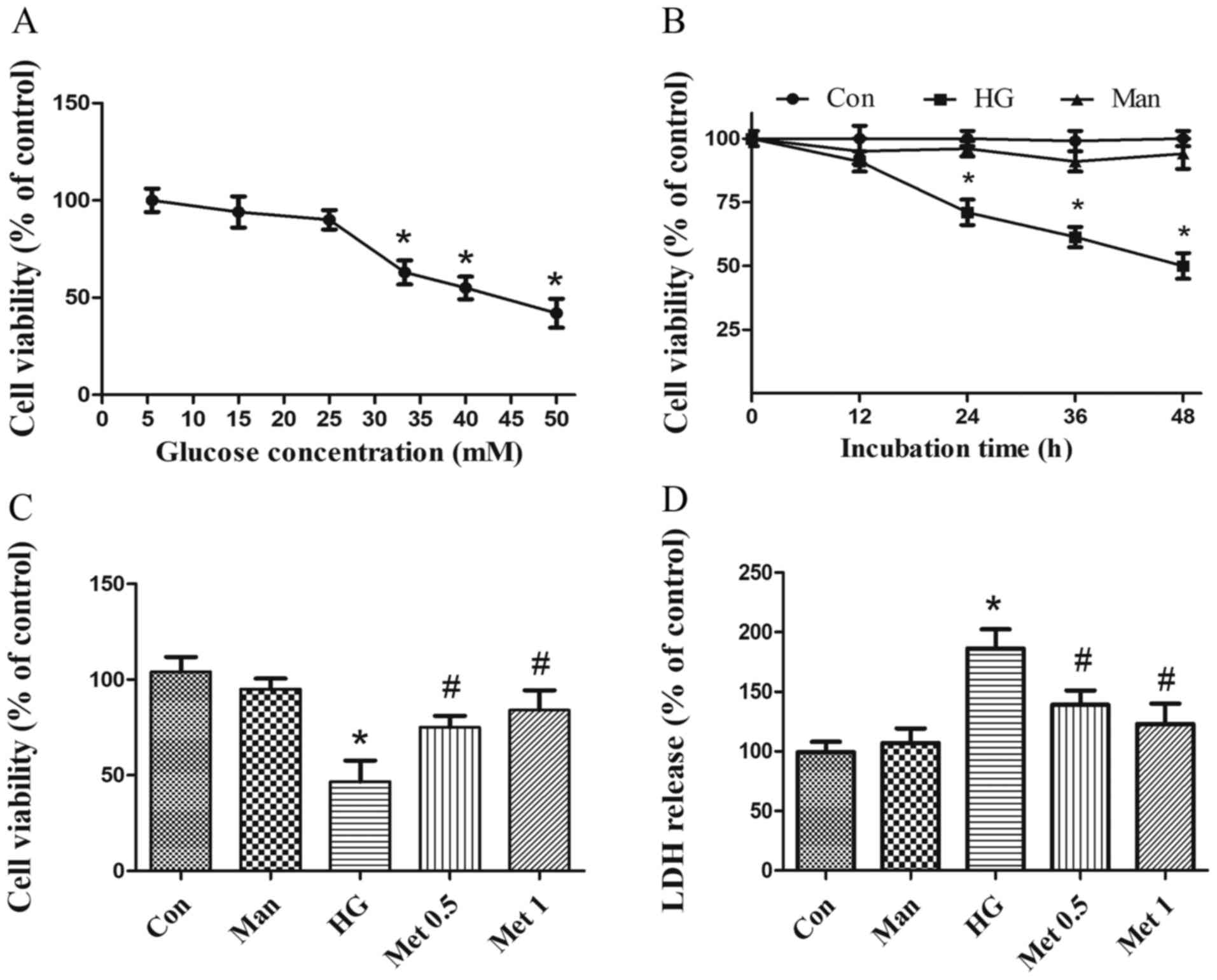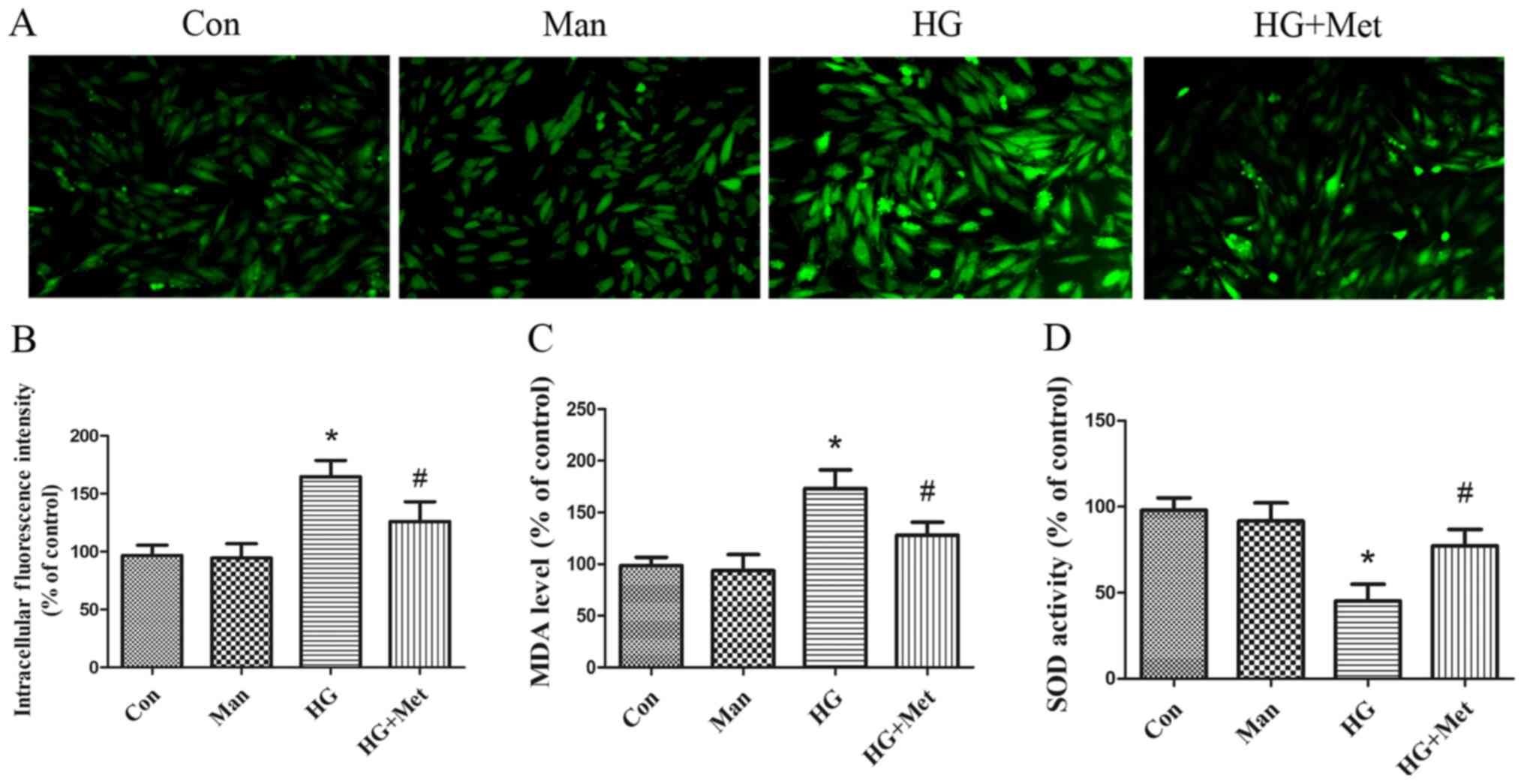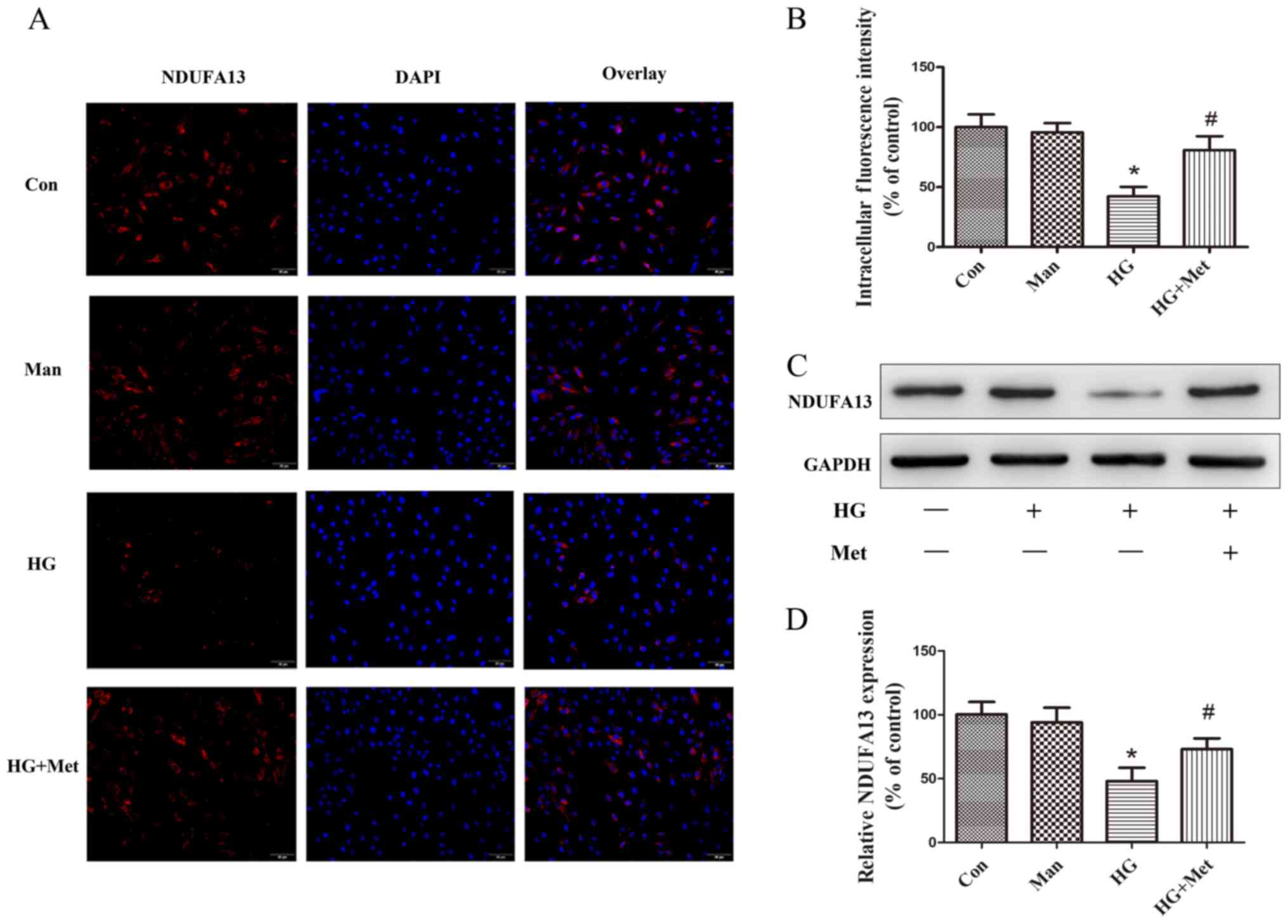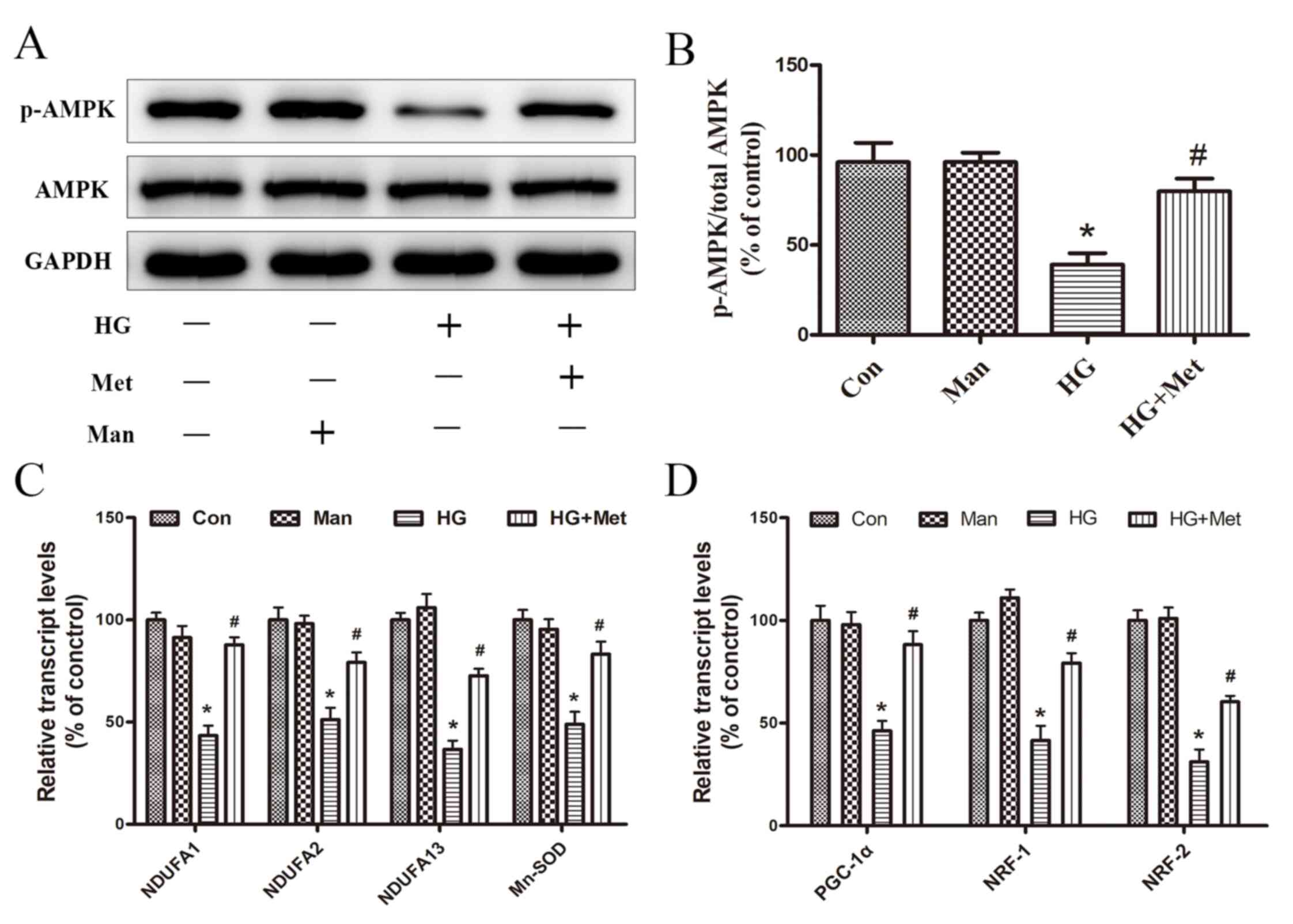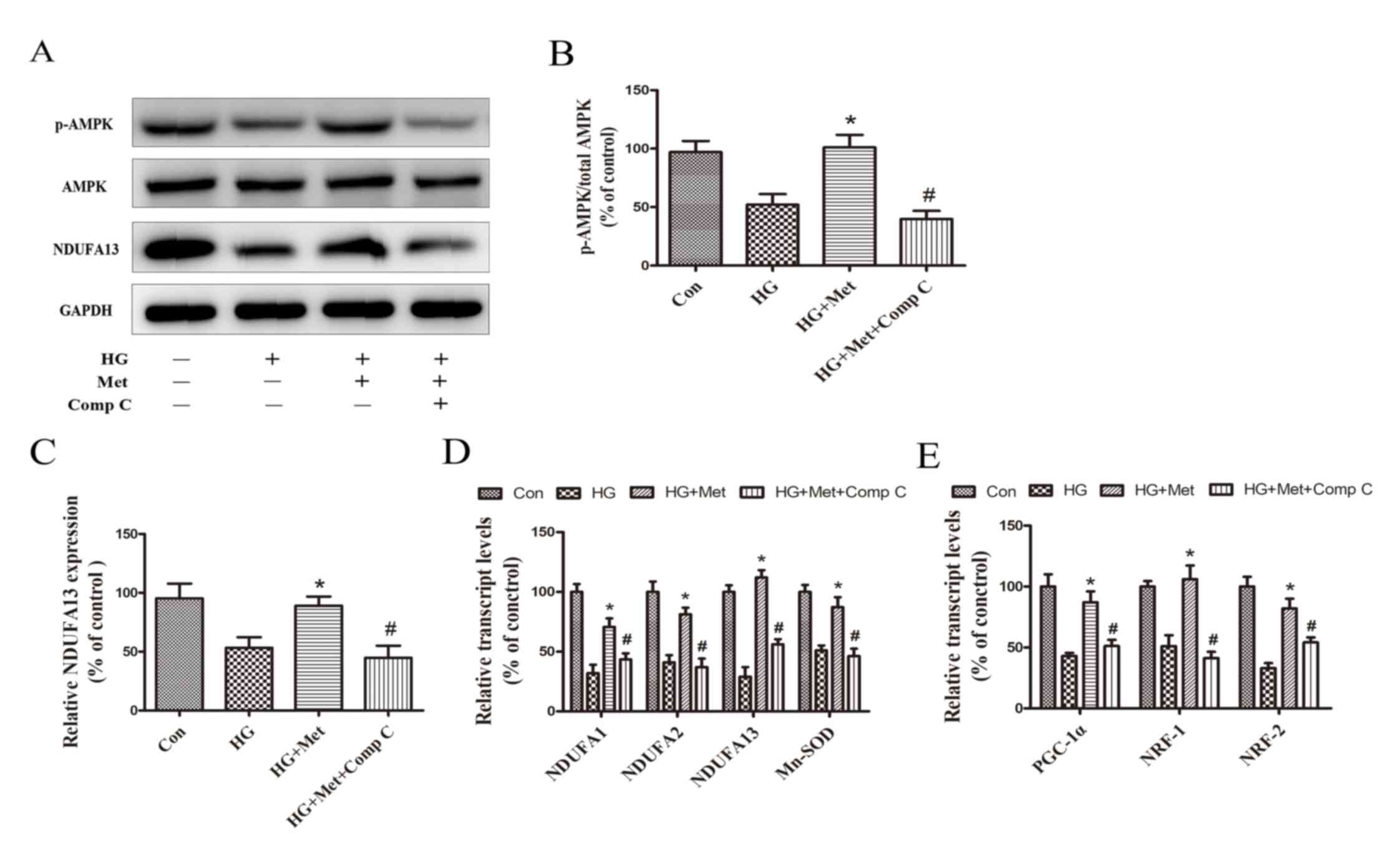|
1
|
Hayat SA, Patel B, Khattar RS and Malik
RA: Diabetic cardiomyopathy: Mechanisms, diagnosis and treatment.
Clin Sci (Lond). 107:539–557. 2004.PubMed/NCBI
|
|
2
|
Cai L and Kang YJ: Oxidative stress and
diabetic cardiomyopathy: A brief review. Cardiovasc Toxicol.
1:181–193. 2001.PubMed/NCBI
|
|
3
|
Khullar M, Al-Shudiefat AA, Ludke A,
Binepal G and Singal PK: Oxidative stress: A key contributor to
diabetic cardiomyopathy. Can J Physiol Pharmacol. 88:233–240.
2010.PubMed/NCBI
|
|
4
|
Sanchez-rangel E and Inzucchi SE:
Metformin: Clinical use in type 2 diabetes. Diabetologia.
60:1586–1593. 2017.PubMed/NCBI
|
|
5
|
Intensive blood-glucose control with
sulphonylureas or insulin compared with conventional treatment and
risk of complications in patients with type 2 diabetes (UKPDS 33).
UK prospective diabetes study (UKPDS) group. Lancet. 352:837–853.
1998.PubMed/NCBI
|
|
6
|
Varjabedian L, Bourji M, Pourafkari L and
Nader ND: Cardioprotection by metformin: Beneficial effects beyond
glucose reduction. Am J Cardiovasc Drugs. 18:181–193.
2018.PubMed/NCBI
|
|
7
|
Calvert JW, Gundewar S, Jha S, Greer JJM,
Bestermann WH, Tian R and Lefer DJ: Acute metformin therapy confers
cardioprotection against myocardial infarction via
AMPK-eNOS-mediated signaling. Diabetes. 57:696–705. 2008.PubMed/NCBI
|
|
8
|
Hu M, Ye P, Liao H, Chen M and Yang F:
Metformin protects H9C2 cardiomyocytes from high-glucose and
hypoxia/reoxygenation injury via inhibition of reactive oxygen
species generation and inflammatory responses: Role of AMPK and
JNK. J Diabetes Res. 2016:29619542016.PubMed/NCBI
|
|
9
|
Kim AS, Miller EJ and Young LH:
AMP-activated protein kinase: A core signalling pathway in the
heart. Acta Physiol (Oxf). 196:37–53. 2009.PubMed/NCBI
|
|
10
|
Paiva MA, Rutter-Locher Z, Gonçalves LM,
Providência LA, Davidson SM, Yellon DM and Mocanu MM: Enhancing
AMPK activation during ischemia protects the diabetic heart against
reperfusion injury. Am J Physiol Heart Circ Physiol.
300:H2123–H2134. 2011.PubMed/NCBI
|
|
11
|
Kusmic C, L'abbate A, Sambuceti G,
Drummond G, Barsanti C, Matteucci M, Cao J, Piccolomini F, Cheng J
and Abraham NG: Improved myocardial perfusion in chronic diabetic
mice by the up-regulation of pLKB1 and AMPK signaling. J Cell
Biochem. 109:1033–1044. 2010.PubMed/NCBI
|
|
12
|
Zheng A, Li H, Xu J, Cao K, Li H, Pu W,
Yang Z, Peng Y, Long J, Liu J and Feng Z: Hydroxytyrosol improves
mitochondrial function and reduces oxidative stress in the brain of
db/db mice: Role of AMP-activated protein kinase activation. Br J
Nutr. 113:1667–1676. 2015.PubMed/NCBI
|
|
13
|
Vakifahmetoglu-norberg H, Ouchida AT and
Norberg E: The role of mitochondria in metabolism and cell death.
Biochem Biophys Res Commun. 482:426–431. 2017.PubMed/NCBI
|
|
14
|
Huang G, Lu H, Hao A, Ng DC, Ponniah S,
Guo K, Lufei C, Zeng Q and Cao X: GRIM-19, a cell death regulatory
protein, is essential for assembly and function of mitochondrial
complex I. Mol Cell Biol. 24:8447–8456. 2004.PubMed/NCBI
|
|
15
|
Li YG, Han BB, Li F, Yu JW, Dong ZF, Niu
GM, Qing YW, Li JB, Wei M and Zhu W: High glucose induces
down-regulated GRIM-19 expression to activate STAT3 signaling and
promote cell proliferation in cell culture. PLoS One.
11:e01536592016.PubMed/NCBI
|
|
16
|
Sazanov LA: Respiratory complex I:
Mechanistic and structural insights provided by the crystal
structure of the hydrophilic domain. Biochemistry. 46:2275–2288.
2007.PubMed/NCBI
|
|
17
|
Zhang Y, Liu X, Zhang L, Li X, Zhou Z,
Jiao L, Shao Y, Li M, Leng B, Zhou Y, et al: Metformin protects
against H2O2-induced cardiomyocyte injury by inhibiting the
miR-1a-3p/GRP94 pathway. Mol Ther Nucleic Acids. 13:189–197.
2018.PubMed/NCBI
|
|
18
|
Chang J, Jung HH, Yang JY, Lee S, Choi J,
Im GJ and Chae SW: Protective effect of metformin against
cisplatin-induced ototoxicity in an auditory cell line. J Assoc Res
Otolaryngol. 15:149–158. 2014.PubMed/NCBI
|
|
19
|
Livak KJ and Schmittgen TD: Analysis of
relative gene expression data using real-time quantitative PCR and
the 2(-Delta Delta C(T)) method. Method. 408:402–408. 2001.
|
|
20
|
Foretz M, Guigas B, Bertrand L, Pollak M
and Viollet B: Metformin: From mechanisms of action to therapies.
Cell Metab. 20:953–966. 2014.PubMed/NCBI
|
|
21
|
Dowling RJO, Lam S, Bassi C, Mouaaz S,
Aman A, Kiyota T, Al-Awar R, Goodwin PJ and Stambolic V: Metformin
pharmacokinetics in mouse tumors: Implications for human therapy.
Cell Metab. 23:567–568. 2016.PubMed/NCBI
|
|
22
|
Xie L, Zhu X, Hu Y, Li T, Gao Y, Shi Y and
Tang S: Mitochondrial DNA oxidative damage triggering mitochondrial
dysfunction and apoptosis in high glucose-induced HRECs. Invest
Ophthalmol Vis Sci. 49:4203–4209. 2008.PubMed/NCBI
|
|
23
|
Kukidome D, Nishikawa T, Sonoda K, Imoto
K, Fujisawa K, Yano M, Motoshima H, Taguchi T, Matsumura T and
Araki E: Activation of AMP-activated protein kinase reduces
hyperglycemia-induced mitochondrial reactive oxygen species
production and promotes mitochondrial biogenesis in human umbilical
vein endothelial cells. Diabetes. 55:120–127. 2006.PubMed/NCBI
|
|
24
|
Yan W, Zhang H, Liu P, Wang H, Liu J, Gao
C, Liu Y, Lian K, Yang L, Sun L, et al: Impaired mitochondrial
biogenesis due to dysfunctional adiponectin-AMPK-PGC-1α signaling
contributing to increased vulnerability in diabetic heart. Basic
Res Cardiol. 108:3292013.PubMed/NCBI
|
|
25
|
Karnewar S, Neeli PK, Panuganti D,
Kotagiri S, Mallappa S, Jain N, Jerald MK and Kotamraju S:
Metformin regulates mitochondrial biogenesis and senescence through
AMPK mediated H3K79 methylation: Relevance in age-associated
vascular dysfunction. Biochim Biophys Acta Mol Basis Dis.
1864:1115–1128. 2018.PubMed/NCBI
|
|
26
|
Chen SD, Yang DI, Lin TK, Shaw FZ, Liou CW
and Chuang YC: Roles of oxidative stress, apoptosis, PGC-1α and
mitochondrial biogenesis in cerebral ischemia. Int J Mol Sci.
12:7199–7215. 2011.PubMed/NCBI
|
|
27
|
Adeghate E and Singh J: Structural changes
in the myocardium during diabetes-induced cardiomyopathy. Heart
Fail Rev. 19:15–23. 2014.PubMed/NCBI
|
|
28
|
Nanjaiah H and Vallikannan B: Enhanced
phosphorylation of AMPK by lutein and oxidised lutein that lead to
mitochondrial biogenesis in hyperglycemic HepG2 cells. J Cell
Biochem. 120:15255–15267. 2019.PubMed/NCBI
|
|
29
|
Zong H, Ren JM, Young LH, Pypaert M, Mu J,
Birnbaum MJ and Shulman GI: AMP kinase is required for
mitochondrial biogenesis in skeletal muscle in response to chronic
energy deprivation. Proc Natl Acad Sci USA. 99:15983–15987.
2002.PubMed/NCBI
|
|
30
|
Song P, Kwon Y, Yea K, Moon HY, Yoon JH,
Ghim J, Hyun H, Kim D, Koh A, Berggren PO, et al: Apolipoprotein a1
increases mitochondrial biogenesis through AMP-activated protein
kinase. Cell Signal. 27:1873–1881. 2015.PubMed/NCBI
|
|
31
|
Aquilano K, Baldelli S, Pagliei B, Cannata
SM, Rotilio G and Ciriolo MR: p53 orchestrates the PGC-1α-mediated
antioxidant response upon mild redox and metabolic imbalance.
Antioxid Redox Signal. 18:386–399. 2013.PubMed/NCBI
|
|
32
|
Moreira S, Correia M, Soares P and Máximo
V: GRIM-19 function in cancer development. Mitochondrion.
11:693–699. 2011.PubMed/NCBI
|
|
33
|
Fato R, Bergamini C, Leoni S, Strocchi P
and Lenaz G: Generation of reactive oxygen species by mitochondrial
complex I: Implications in neurodegeneration. Neurochem Res.
33:2487–2501. 2008.PubMed/NCBI
|
|
34
|
Hu H, Nan J, Sun Y, Zhu D, Xiao C, Wang Y,
Zhu L, Wu Y, Zhao J, Wu R, et al: Electron leak from NDUFA13 within
mitochondrial complex I attenuates ischemia-reperfusion injury via
dimerized STAT3. Proc Natl Acad Sci USA. 114:11908–11913.
2017.PubMed/NCBI
|
|
35
|
Williams MD, Van Remmen H, Conrad CC,
Huang TT, Epstein CJ and Richardson A: Increased oxidative damage
is correlated to altered mitochondrial function in heterozygous
manganese superoxide dismutase knockout mice. J Biol Chem.
273:28510–28515. 1998.PubMed/NCBI
|
|
36
|
Yu PB, Hong CC, Sachidanandan C, Babitt
JL, Deng DY, Hoyng SA, Lin HY, Bloch KD and Peterson RT:
Dorsomorphin inhibits BMP signals required for embryogenesis and
iron metabolism. Nat Chem Biol. 4:33–41. 2008.PubMed/NCBI
|
|
37
|
Hao J, Ho JN, Lewis JA, Karim KA, Daniels
RN, Gentry PR, Hopkins CR, Lindsley CW and Hong CC: In vivo
structure-activity relationship study of dorsomorphin analogues
identifies selective VEGF and BMP inhibitors. ACS Chem Biol.
5:245–253. 2010.PubMed/NCBI
|















